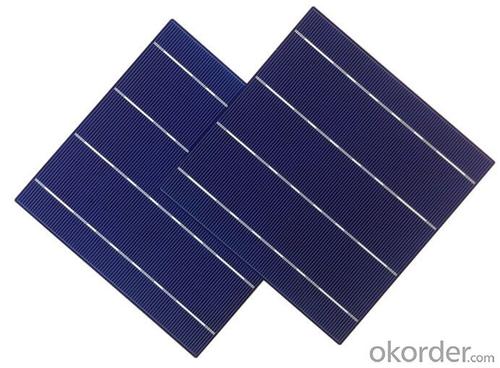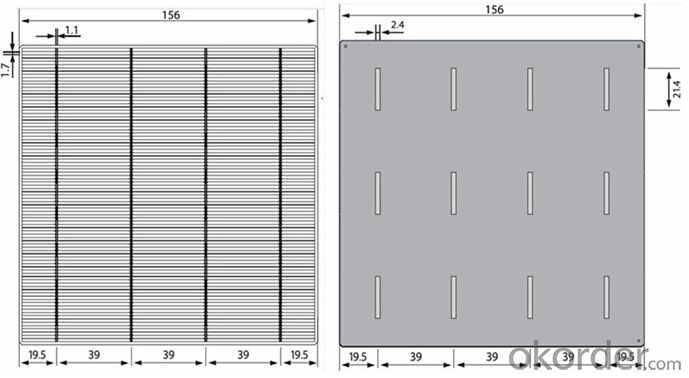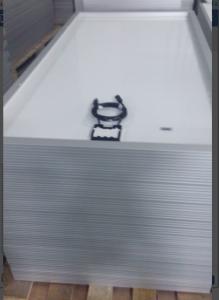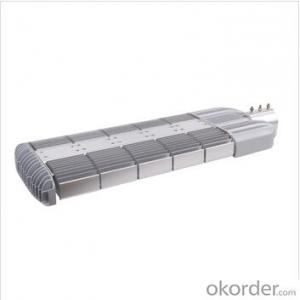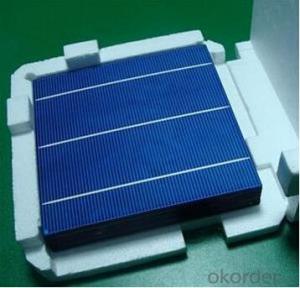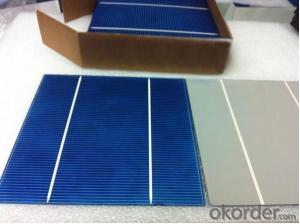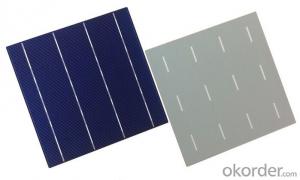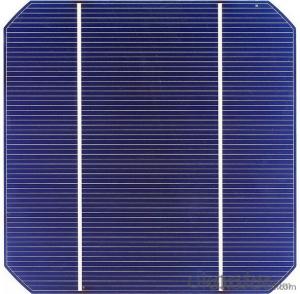Us Manufactured Solar Panels - A Grade and B Grade 3BB and 4BB High Efficiency 19.2% Solar Cells
- Loading Port:
- Shanghai
- Payment Terms:
- TT OR LC
- Min Order Qty:
- 10000 watt
- Supply Capability:
- 100000000 watt/month
OKorder Service Pledge
OKorder Financial Service
You Might Also Like
Specification
1.Product Description:
Specifications of Poly Solar Cells
Dimension | 156mm X 156 mm ±0.5mm |
Wafer Thickness | 200um ±30um |
Front(-) | Four 1.1mm wide bus bars(silver) with distance 39mm, Acid texturized surface with blue silicon nitride AR coating. |
Back(+) | 2.4mm wide silver/aluminum soldering pads, aluminum back surface field. |
Temperature Coefficient of Poly Cells
Voc.Temp .coef.%/K | -0.351%/K |
Isc.Temp .coef.%/K | +0.035%/K |
Pm.Temp. coef.%/K | -0.47%/K |
Electrical Characteristic of Poly Cells
Efficiency code | 1720 | 1740 | 1760 | 1780 | 1820 | 1840 | |
Efficiency (min) | (%) | 17.2 | 17.4 | 17.6 | 17.8 | 18.2 | 18.4 |
Pmax | (W) | 4.186 | 4.234 | 4.283 | 4.332 | 4.429 | 4.478 |
Voc | (V) | 0.631 | 0.632 | 0.634 | 0.636 | 0.640 | 0.642 |
Isc | (A) | 8.446 | 8.485 | 8.523 | 8.573 | 8.660 | 8.700 |
Vmp | (V) | 0.525 | 0.527 | 0.529 | 0.531 | 0.535 | 0.537 |
Imp | (A) | 7.973 | 8.035 | 8.097 | 8.160 | 8.280 | 8.340 |
2.Advantages of Poly Solar Cells
1). Tire-1 Solar Cells’ Manufacturer Quality Guarantee. With a complete and sophisticated quality government system, our Quality Management have arrived world’s leading place. Customer can receive Tire-1 Cells Maker’s Quality Standard Products.
2). Trusted Warranty. We can supply trusted after-sales service to our customer. If our cells are found not in conformity to the specification of manufacturer, or should the inspected quantity found in shortage, or should the packing found damaged, the buyer has the right to claim to the seller. The claim, if any, should be presented to seller within 30 days after cargo's arrival date to the port, together with related inspection report and photos issued and provided by a reputable independent surveyor such as SGS.
3). World’s Leading Manufacturer Equipment. We imported the newest and leading production equipment from abroad. Advanced equipment can guarantee the stable quality of cells. Auto production line can also save labor cost which will further cut our production cost.
4). Bulk supply: With the production capacity of 500MW, we can produce large quantity every month. This can satisfy most customer requirement.
3.Usage and Applications of Poly Cells
Solar cells are often electrically connected and encapsulated as a module.
Photovoltaic modules often have a sheet of glass on the front (sun up) side, allowing light to pass while protecting the semiconductor wafers from abrasion and impact due to wind-driven debris, rain, hail, etc. Solar cells are also usually connected in series in modules, creating an additive voltage.
Connecting cells in parallel will yield a higher current;our solar cells have passed IEC Certification.
With high quality and stable quality. Our Cells can greatly improve the performance of Solar Modules.
4.Pictures of Product
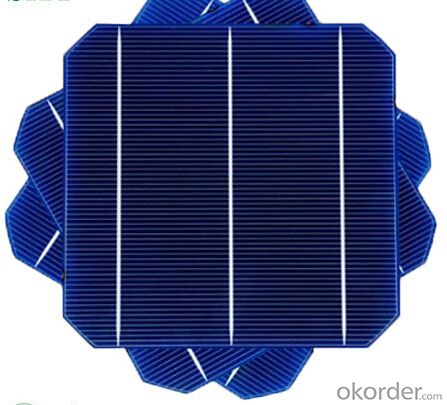

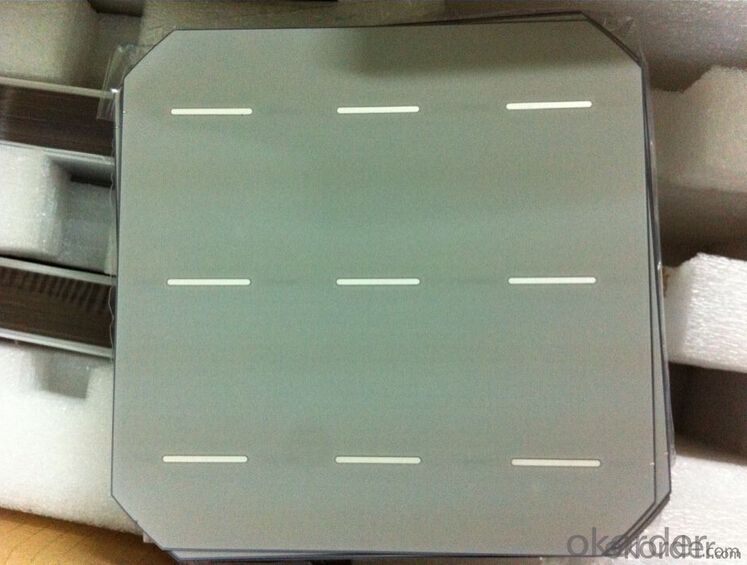
5.Packaging & Delivery of Poly Cells
Carton Box Package and Deliver by air. It should be noticed that it should be avoid water, sunshine and moist.
We have organized several common questions for our clients,may help you sincerely:
6.FAQ
1. What’s price per watt?
A: It’s depends on the quantity, delivery date and payment terms of the order. We can talk further about the detail price issue. Our products is high quality with lower price level.
2. Can you tell me the parameter of your solar cells?
We have different series of cells with different power output, both from c-si to a-si. Please take our specification sheet for your reference.
3. How do you pack your products?
We have rich experience on how to pack the panels to make sure the safety on shipment when it arrives at the destination.
4. Can you do OEM for us?
Yes, we can.
5. How long can we receive the product after purchase?
In the purchase of product within three working days, We will arrange the factory delivery as soon as possible. The perfect time of receiving is related to the state and position of customers. Commonly 7 to 10 working days can be served.
- Q: Can solar panels be installed on the ground?
- Yes, solar panels can be installed on the ground. Ground-mounted solar panel systems are commonly used in residential, commercial, and utility-scale applications. They offer flexibility in terms of sizing, orientation, and tilt angle, allowing for optimal solar energy generation. Ground-mounted systems also eliminate the need for roof modifications or space constraints, making them a popular choice for many solar installations.
- Q: How do solar panels affect the property's curb appeal?
- Solar panels can enhance the curb appeal of a property by providing a modern and sustainable aesthetic. They showcase the homeowner's commitment to renewable energy, which is increasingly valued by prospective buyers.
- Q: the solar panel works with LEDs, small bulbs,etc but neve with any dcmotor. Please help. I have a science exhibition.
- It may be that the power output of your solar panel is not enough to drive the DC motor. It is producing up to 6 volts but it may not be producing many milliamps. LEDs need very little power to work but DC motors often need quite a high current to get them turning. If you can run several solar panels in parallel, you can probably increase the available current. Alternatively, can you expose the existing panel to much more light so as to get it to work at its maximum output? That might work. Good luck with your science exhibition.
- Q: How do solar panels affect the grid during times of high electricity demand?
- Solar panels can help alleviate the strain on the grid during times of high electricity demand by generating clean and renewable energy. By producing electricity directly from sunlight, solar panels can contribute to the overall power supply and decrease the reliance on traditional fossil fuel sources. This reduces the burden on the grid, mitigates the risk of blackouts, and helps meet the increased energy demand more sustainably.
- Q: If you were to be asked to write a material(s) report on either -solar panelsor -aircraft fuselageWhich would you choose?well i was asked to choose between these two,so i guess that if i choose what the majority wouldn't, i might just score a little bit higher,what do you think?if you are the lecturer you would want something different right?
- Fuselage, solar panels are boring...check out the design considerations for the fuselage of the old SR-7 Blackbird, a really amazing aircraft in its day.
- Q: Could you throw some long scientific words in with your answer so I can impress my teacher, I'm looking to expand my scientific vocab. Thanks
- Solar panels are a generic term for any type of solar collecting panel. There are two major types: Photovoltaic uses substances that turn the incoming radiation directly into electricity. Usually you have to have direct sunlight (no clouds) for this to work well. Solar thermal is also used in a lot of areas. Here the radiation is used to heat a circulating fluid (often water directly), and then that is either used directly, or it's used for heat exchange with a heat pump or a boiler system. Solar thermal can collect significant heat even on a cloudy day. So a solar panel could be made of photovoltaic panels, but it doesn't have to be.
- Q: I am doing a project for school and i need to power a 9v DC motor using a solar panel. Does anyone know places i could get these for not to expensive, and how many volts/watts i would need?
- Jameco okorder /
- Q: Does San Francisco get enough sunshine to really make solar panels a viable option for creating a self-supporting home? Certainly a wind turbine would be a good source of energy, but what about solar panels? Does S.F. get enough sunshine to justify using solar panels? It's overcast a lot in the Bay Area, are there any solar panels better than others for a climate like this?
- Yes, San Francisco gets enough sunshine. That will vary depending on your site location, some are better than others. The best way to find out how much electricity your specific location can generate is to get a quote from a solar company. I am in the process of getting PV's installed on my home in the Sacto area and got quotes from 3 companies. My home is in a good, not optimal possition and depending on where on the roof I place the panels my efficiency will vary. Also depending on the brand of panels, some will take less square footage on the roof to produce the same amount of electricity. The price on all 3 were very close to each other. All 3 companies I dealt with gave a no cost/no obligation quote, and they were are very knowledgeable about the specific utility rebates I would be eligable for. I say it is well worth the time to check it out. My system should be going onto my roof in just a few more weeks. I was able to get nearly 50% of my cost refunded by my utitlity, plus my federal tax rebate. My system should be paid for in about 6 years.
- Q: hey, i am wanting to help our earth a little bit, and I was wondering how to do a solar panel connection for powering my home.... i just want to reduce my energy bill a little bit, Would these solar panels work?and how would i connect them?
- Hello, Yes you definitely can use this kind of panels. Powering your home entirely will be an issue if you are not familiar with solar energy and electricity in general. If it's the case I'm afraid you'll need a specialist. The basic principle of a solar power system: - Solar panel to charge the batteries - DC to AC converter that will convert the DC voltage from your battery to AC voltage so that you can connect regular home appliances like lights or TV.
- Q: Basically I need a custom solar panel created. I won't go into detail but the dimensions need to be around 4''x2.5'' and be as thin as possible.
- Make okorder
Send your message to us
Us Manufactured Solar Panels - A Grade and B Grade 3BB and 4BB High Efficiency 19.2% Solar Cells
- Loading Port:
- Shanghai
- Payment Terms:
- TT OR LC
- Min Order Qty:
- 10000 watt
- Supply Capability:
- 100000000 watt/month
OKorder Service Pledge
OKorder Financial Service
Similar products
Hot products
Hot Searches
Related keywords


